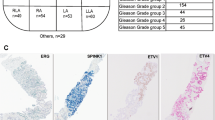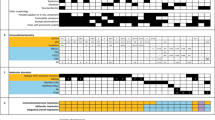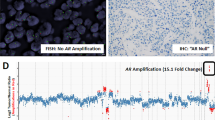Abstract
Background:
Overexpression of the ERG protein is highly prevalent in prostate cancer (PCa) and commonly results from gene fusions involving the ERG gene. Recently, N-terminal epitope-targeted mouse and a C-terminal epitope-targeted rabbit monoclonal anti-ERG antibody (ERG-MAbs) have been introduced for the detection of the ERG protein. Independent studies reported that immunohistochemistry (IHC) with both ERG-MAbs highly correlates with the underlying ERG gene rearrangement status. However, comparative studies of both antibodies are lacking. Here, we are among the first to compare the mouse ERG-MAb with the rabbit ERG-MAb for their concordance on the same PCa cohort. Furthermore, we assessed whether the ERG protein expression is conserved in lymph node and distant PCa metastases.
Methods:
We evaluated tissue microarrays of 278 specimens containing 265 localized PCa, 29 lymph node, 30 distant metastases and 13 normal prostatic tissues. We correlated ERG protein expression with ERG rearrangement status using an ERG break-apart fluorescence in-situ hybridization assay and IHC of both ERG-MAbs.
Results:
ERG expression and ERG rearrangement status were highly concordant regardless of whether the mouse or rabbit ERG-MAb was used (97.8% versus 98.6%, respectively). Of interest, both ERG antibodies reliably detected the ERG expression in lymph node and distant PCa metastases, of which a subset underwent decalcification. Lymphocytes only revealed immunoreactivity using the rabbit ERG-MAb. If ERG protein expression was present in localized PCa, we observed the same pattern in the corresponding lymph node metastases.
Conclusions:
By demonstrating a broad applicability of IHC to study ERG protein expression using either antibody, this study adds an important step toward a facilitated routine clinical application. Further, we demonstrate that the clonal nature of the ERG rearrangement is not restricted to the genomic level, but proceeds in the proteome. Together, our results simplify future efforts to further eliucidate the biological role of ERG in PCa.
This is a preview of subscription content, access via your institution
Access options
Subscribe to this journal
Receive 4 print issues and online access
$259.00 per year
only $64.75 per issue
Buy this article
- Purchase on Springer Link
- Instant access to full article PDF
Prices may be subject to local taxes which are calculated during checkout

Similar content being viewed by others
References
Tomlins SA, Rhodes DR, Perner S, Dhanasekaran SM, Mehra R, Sun XW et al. Recurrent fusion of TMPRSS2 and ETS transcription factor genes in prostate cancer. Science 2005; 310: 644–648.
Tomlins SA, Bjartell A, Chinnaiyan AM, Jenster G, Nam RK, Rubin MA et al. ETS gene fusions in prostate cancer: from discovery to daily clinical practice. Eur Urol 2009; 56: 275–286.
Clark JP, Cooper CS . ETS gene fusions in prostate cancer. Nat Rev Urol 2009; 6: 429–439.
Petrovics G, Liu A, Shaheduzzaman S, Furasato B, Sun C, Chen Y et al. Frequent overexpression of ETS-related gene-1 (ERG1) in prostate cancer transcriptome. Oncogene 2005; 24: 3847–3852.
Rostad K, Mannelqvist M, Halvorsen OJ, Oyan AM, Bo TH, Stordrange L et al. ERG upregulation and related ETS transcription factors in prostate cancer. Int J Oncol 2007; 30: 19–32.
Cerveira N, Ribeiro FR, Peixoto A, Costa V, Henrique R, Jeronimo C et al. TMPRSS2-ERG gene fusion causing ERG overexpression precedes chromosome copy number changes in prostate carcinomas and paired HGPIN lesions. Neoplasia 2006; 8: 826–832.
Braun M, Scheble VJ, Menon R, Scharf G, Wilbertz T, Petersen K et al. Relevance of cohort design for studying the frequency of the ERG rearrangement in prostate cancer. Histopathology 2011; 58: 1028–1036.
Falzarano SM, Navas M, Simmerman K, Klein EA, Rubin MA, Zhou M et al. ERG rearrangement is present in a subset of transition zone prostatic tumors. Mod Pathol 2010; 23: 1499–1506.
Williamson SR, Zhang S, Yao JL, Huang J, Lopez-Beltran A, Shen S et al. ERG-TMPRSS2 rearrangement is shared by concurrent prostatic adenocarcinoma and prostatic small cell carcinoma and absent in small cell carcinoma of the urinary bladder: evidence supporting monoclonal origin. Mod Pathol 2011; 24: 1120–1127.
Lotan TL, Gupta NS, Wang W, Toubaji A, Haffner MC, Chaux A et al. ERG gene rearrangements are common in prostatic small cell carcinomas. Mod Pathol 2011; 24: 820–828.
Han B, Mehra R, Suleman K, Tomlins SA, Wang L, Singhal N et al. Characterization of ETS gene aberrations in select histologic variants of prostate carcinoma. Mod Pathol 2009; 22: 1176–1185.
Scheble VJ, Braun M, Wilbertz T, Stiedl AC, Petersen K, Schilling D et al. ERG rearrangement in small cell prostatic and lung cancer. Histopathology 2010; 56: 937–943.
Perner S, Demichelis F, Beroukhim R, Schmidt FH, Mosquera JM, Setlur S et al. TMPRSS2:ERG fusion-associated deletions provide insight into the heterogeneity of prostate cancer. Cancer Res 2006; 66: 8337–8341.
Mehra R, Tomlins SA, Yu J, Cao X, Wang L, Menon A et al. Characterization of TMPRSS2-ETS gene aberrations in androgen-independent metastatic prostate cancer. Cancer Res 2008; 68: 3584–3590.
Attard G, Swennenhuis JF, Olmos D, Reid AH, Vickers E, A’Hern R et al. Characterization of ERG, AR and PTEN gene status in circulating tumor cells from patients with castration-resistant prostate cancer. Cancer Res 2009; 69: 2912–2918.
Perner S, Svensson MA, Hossain RR, Day JR, Groskopf J, Slaughter RC et al. ERG rearrangement metastasis patterns in locally advanced prostate cancer. Urology 2009; 75: 762–767.
Perner S, Mosquera JM, Demichelis F, Hofer MD, Paris PL, Simko J et al. TMPRSS2-ERG fusion prostate cancer: an early molecular event associated with invasion. Am J Surg Pathol 2007; 31: 882–888.
Scheble VJ, Braun M, Beroukhim R, Mermel CH, Ruiz C, Wilbertz T et al. ERG rearrangement is specific to prostate cancer and does not occur in any other common tumor. Mod Pathol 2010; 23: 1061–1067.
Furusato B, Tan SH, Young D, Dobi A, Sun C, Mohamed AA et al. ERG oncoprotein expression in prostate cancer: clonal progression of ERG-positive tumor cells and potential for ERG-based stratification. Prostate Cancer Prostatic Dis 2010; 13: 228–237.
van Leenders GJ, Boormans JL, Vissers CJ, Hoogland AM, Bressers AA, Furusato B et al. Antibody EPR3864 is specific for ERG genomic fusions in prostate cancer: implications for pathological practice. Mod Pathol 2011; 24: 1128–1138.
Park K, Tomlins SA, Mudaliar KM, Chiu YL, Esgueva R, Mehra R et al. Antibody-based detection of ERG rearrangement-positive prostate cancer. Neoplasia 2010; 12: 590–598.
He H, Magi-Galluzzi C, Li J, Carver P, Falzarano S, Smith K et al. The diagnostic utility of novel immunohistochemical marker ERG in the workup of prostate biopsies with ‘atypical glands suspicious for cancer’. Am J Surg Pathol 2011; 35: 608–614.
Hu Y, Dobi A, Sreenath T, Cook C, Tadase AY, Ravindranath L et al. Delineation of TMPRSS2-ERG splice variants in prostate cancer. Clin Cancer Res 2008; 14: 4719–4725.
Miettinen M, Wang ZF, Paetau A, Tan SH, Dobi A, Srivastava S et al. ERG transcription factor as an immunohistochemical marker for vascular endothelial tumors and prostatic carcinoma. Am J Surg Pathol 2011; 35: 432–441.
Wang J, Cai Y, Yu W, Ren C, Spencer DM, Ittmann M . Pleiotropic biological activities of alternatively spliced TMPRSS2/ERG fusion gene transcripts. Cancer Res 2008; 68: 8516–8524.
Wang J, Cai Y, Ren C, Ittmann M . Expression of variant TMPRSS2/ERG fusion messenger RNAs is associated with aggressive prostate cancer. Cancer Res 2006; 66: 8347–8351.
Clark J, Merson S, Jhavar S, Flohr P, Edwards S, Foster CS et al. Diversity of TMPRSS2-ERG fusion transcripts in the human prostate. Oncogene 2007; 26: 2667–2673.
Dobi A, Furusato B, Shaheduzzaman S, Chen Y, Vahey M, Nydam T et al. ERG expression levels in prostate tumors reflect functional status of the androgen receptor (AR) as a consequence of fusion of ERG with AR regulated gene promoter. Open Cancer J 2010; 3: 101–108.
Mohamed AA, Tan SH, Mikhalkevich N, Ponniah S, Vasioukhin V, Bieberich CJ et al. Ets family protein, erg expression in developing and adult mouse tissues by a highly specific monoclonal antibody. J Cancer 2010; 1: 197–208.
Acknowledgements
This work was supported by a Grant of the German Research Foundation (Deutsche Forschungsgemeinschaft (DFG), Emmy-Noether-Program, PE1179/2-1) and the Rudolf-Becker-Foundation to S P, and by a Grant of the DFG (WE1104/11-1) and German Cancer Aid (Deutsche Krebshilfe, 107827) to N W The development of mouse ERG-Mab was supported by Grants DoD, CDMRP, Grant PC073614 to A D; and Center for Prostate Disease Research Program.
Author information
Authors and Affiliations
Corresponding author
Ethics declarations
Competing interests
The Brigham and Women's Hospital and the University of Michigan have filed a patent on ETS gene rearrangements in PCa, on which S P is a co-inventor and the diagnostic field of use has been licensed to GenProbe (San Diego, CA, USA). GenProbe did not have a role in the design and conduct of the study, in the collection, analysis or interpretation of the data and had no involvement in the preparation, review or approval of the manuscript. The Henry M Jackson Foundation for the Advancement of Military Medicine has filed a patent application on the mouse monoclonal antibody, ERG-MAb, on which S T and A D are co-inventors and has been licensed to the Biocare Medical (Concord, CA, USA). This study was conducted independent of any involvement from Biocare Medical.
Rights and permissions
About this article
Cite this article
Braun, M., Goltz, D., Adler, D. et al. ERG protein expression and genomic rearrangement status in primary and metastatic prostate cancer—a comparative study of two monoclonal antibodies. Prostate Cancer Prostatic Dis 15, 165–169 (2012). https://doi.org/10.1038/pcan.2011.67
Received:
Revised:
Accepted:
Published:
Issue Date:
DOI: https://doi.org/10.1038/pcan.2011.67
Keywords
This article is cited by
-
EpCAM tumor specificity and proteoform patterns in urothelial cancer
Journal of Cancer Research and Clinical Oncology (2023)
-
Deglycosylation of pathological specimens alters performance of diagnostic PDL1 antibodies
Virchows Archiv (2022)
-
Survey of ERG expression in normal bone marrow and myeloid neoplasms
Journal of Hematopathology (2020)
-
Ethnicity and ERG frequency in prostate cancer
Nature Reviews Urology (2018)
-
Ecotropic viral integration site 1, a novel oncogene in prostate cancer
Oncogene (2017)



